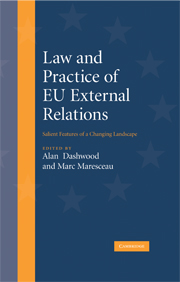Book contents
- Frontmatter
- Contents
- Abbreviations
- Notes on contributors
- Acknowledgements
- Introduction
- PART I Constitutional and institutional questions
- PART II Bilateral and regional approaches
- PART III Selected substantive areas
- 15 With eyes wide shut: the EC strategy to enforce intellectual property rights abroad
- 16 EU environmental law and its green footprints in the world
- Table of Treaty Provisions
- Index
15 - With eyes wide shut: the EC strategy to enforce intellectual property rights abroad
from PART III - Selected substantive areas
Published online by Cambridge University Press: 07 September 2009
- Frontmatter
- Contents
- Abbreviations
- Notes on contributors
- Acknowledgements
- Introduction
- PART I Constitutional and institutional questions
- PART II Bilateral and regional approaches
- PART III Selected substantive areas
- 15 With eyes wide shut: the EC strategy to enforce intellectual property rights abroad
- 16 EU environmental law and its green footprints in the world
- Table of Treaty Provisions
- Index
Summary
Introduction
Intellectual property (IP) protection has gradually occupied a more and more prominent role in the external relations of the EC. Over the last couple of years an important shift is noticeable in the objectives sought to be achieved by the EC, in particular as it interacts with and within the dynamic international context created by the World Trade Organisation (WTO) Agreement on Trade Related Aspects of Intellectual Property (TRIPS Agreement). The conclusion of the latter in 1994 was itself testimony to the more long-standing and still ongoing objective of the EC – and the US – to eliminate piracy and counterfeiting at the source. The minimum levels of worldwide harmonisation imposed by the TRIPS Agreement on all WTO members were to render it possible for (EC) IP holders to prohibit the very production of products without their consent in third countries of exportation. The beneficial effect for the EC was double. Exports markets would be secured through the possibility of obtaining ‘islands of exclusivity’ for IP holders worldwide. Less counterfeit and pirated products would be imported into the EC so that less pressure would be put on the EU external frontier controls. The practice turned out to be somewhat different. For the year 2002, for instance, figures advanced with respect to the number of counterfeit and piracy products intercepted at the EU external frontiers were still as high as 85 million, with an increase between 1998 and 2002 of 800 per cent.
- Type
- Chapter
- Information
- Law and Practice of EU External RelationsSalient Features of a Changing Landscape, pp. 401 - 428Publisher: Cambridge University PressPrint publication year: 2008
- 2
- Cited by

